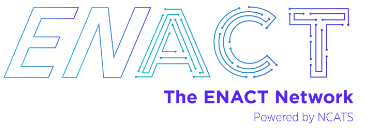
What's Happening
News/Press Releases
03/24/2025
To better support researchers and institutions using the ENACT Network, we introduced our Monthly Informatics Office Hours series. These sessions, held on the second Monday of each month from 3 – 4 pm ET, provide an opportunity to discuss technical challenges, share best practices, and engage directly with our informatics experts. We look forward to continuing these conversations and helping our community make the most of ENACT’s resources.
03/01/2025
ENACT was excited to participate in the 2025 American Medical Informatics Association (AMIA) Conference, where we showcased our latest innovations in data harmonization and real-world evidence generation. Our team presented on key topics, including scalable approaches to integrating EHR data across institutions and strategies for ensuring reproducibility in multi-site research. If you attended AMIA, we hope you connected with us—we enjoyed discussing how ENACT could support your research!
11/13/2024
The ENACT Network made a strong impact at the 2024 Clinical and Translational Science Award (CTSA) Program Meeting, where Dr. Steve Reis presented insights on leveraging multi-institutional electronic health record (EHR) data to advance clinical research. Our presentation highlighted real-world use cases demonstrating how ENACT’s federated data network accelerated discovery while maintaining patient privacy. Attendees engaged in discussions about optimizing data-sharing strategies and fostering cross-institutional collaboration. Thank you to everyone who joined us—we looked forward to continuing the conversation!
Publications
12/16/2025
Mora N, Mehall M, Morlino R, Hopton T, Morrato E, Pincus H.
Lessons learned from sustaining and transitioning a national EHR data network: The ENACT experience applying D&I science frameworks. AcademyHealth 18th Annual Dissemination and Implementation Conference; December 16, 2025; National Harbor, MD. Poster presentation.
10/23/2025
Mora N, Mehall M, Morrato E.
Sustaining electronic health record research networks in academic medical research centers: Insights from implementation science. 2025 Fall CTSA Program Annual Meeting; October 23, 2025. Poster presentation.
08/25/2025
Wang Y, Hilsman J, Li C, Morris M, Heider PM, Fu S, Kwak MJ, Wen A, Applegate JR, Wang L.
Development and Validation of Natural Language Processing Algorithms in the National ENACT Network. Journal of Clinical and Translational Science. 2025:29-Jan.
Grand Rounds
10/20/2025
The ENACT NLP Working Group, established with 13 sites, developed and validated NLP algorithms for rare disease phenotyping, social determinants of health, opioid use disorder, sleep phenotyping, and delirium phenotyping. The group achieved 100% site retention, deployed NLP infrastructure, and extended the ENACT ontology to standardize NLP-derived data. This work demonstrates the feasibility of deploying NLP infrastructure across large, federated networks. Speaker Bio: Dr. Yanshan Wang, Director of the Clinical Natural Language Processing and Artificial Intelligence Innovation Laboratory, will present an overview of the ENACT NLP Working Group. The group is developing methods to extract clinical concepts from narrative notes for deployment in the ENACT network.
09/22/2025
The first knowledge revolution took place in the 15th Century with the invention of the moveable type printing press, which enabled mass access to knowledge. In many ways, efforts to improve health are still based on 15th Century mass access approaches. It is time to achieve a second knowledge revolution--which will enable much more powerful mass action approaches made possible through AI and Learning Health Systems--to improve human health at unprecedented scale.
05/19/2025
Join us for a compelling session that explores how to sustain real-world data (RWD) research networks through the lens of implementation science. What to expect:
Beyond the Grant: Lessons learned on maintaining momentum and impact when funding is reduced or paused. Implementation Science in Action: A review of key principles essential for keeping Real World Data research networks strong and effective.
CTSA Alignment: Direct focus on addressing goals from the CTSA PAR (specificity) programs to ensure long-term relevance and resilience.
Navigating Change: Insights into how networks can adapt in a constantly shifting research environment. This session is a must for researchers and stakeholders committed to sustaining and growing collaborative research efforts.
Presenter Bio:
Elaine H. Morrato, DrPH, MPH, FISPE, CPH, is Professor and Founding Dean of the Parkinson School of Health Sciences and Public Health at Loyola University Chicago. A nationally recognized leader in translational science and implementation research, Dr. Morrato directs Loyola’s CTSA-supported collaboration with the University of Chicago–Rush Institute for Translational Medicine (ITM). She plays a central administrative role in advancing the goals of the Clinical and Translational Science Awards (CTSA) program, particularly around sustainability and dissemination & implementation (D&I) efforts.
As a core member of ENACT’s Dissemination & Evaluation (D&E) Work Group, Dr. Morrato brings expertise in sustaining research infrastructure and innovation ecosystems. She is a co-author of the recent paper, A National Unmet Needs Assessment for CTSA-Affiliated Electronic Health Record Data Networks: A Customer Discovery Approach (Mora et al., 2024), which explores critical gaps in EHR data networks and highlights strategies for sustainability. Her research also focuses on the application of implementation science to improve health systems and the scalability of real-world data networks.
In addition to her work in sustainability, Dr. Morrato has an extensive body of scholarly research in dissemination and implementation science. She has provided expert guidance on pharmaceutical risk communication and safety surveillance to the U.S. Food and Drug Administration and completed a visiting professorship at the FDA’s Office of Surveillance and Epidemiology, Center for Drug Evaluation and Research. Dr. Morrato is also involved in scaling the NIH I-Corps™ program, ensuring that academic innovations are effectively translated to real-world impact.
